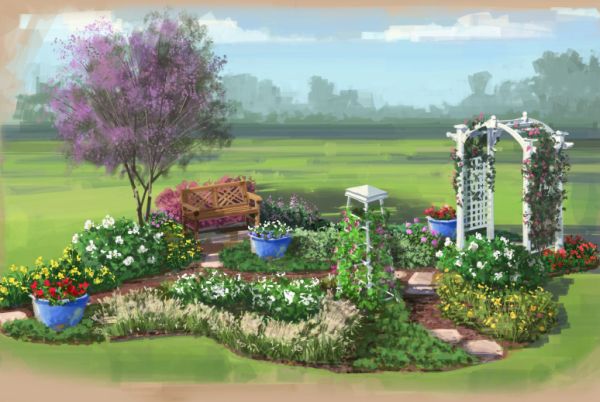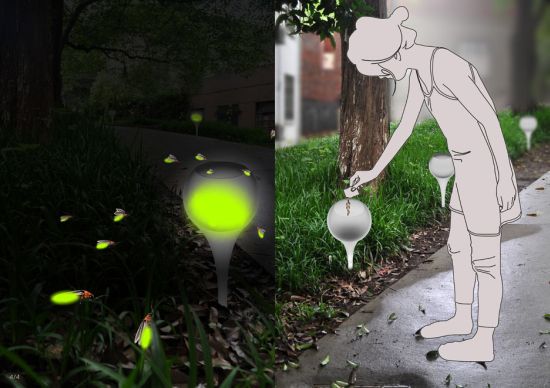Colors induce life in a landscape. Designing a landscape includes selecting the pattern, planning the usage of space, meeting the functional needs, creating activity areas and finally the color. Color is chosen at last because one needs to select it in a way that it complements the other features of landscape design. Colors blend the exterior environment with the design to enhance its beauty further. The art work uplifts your mood and makes your stay at home, enjoyable. It helps you to highlight the areas that you want people to notice. Right selection of colors is a major criterion to give a perfect look to your place.

a. Characteristics of color
Color is the basic thing that appeals to the viewer. It is one such thing that gets appreciation without any struggle. The theory of colors is complex but you must remember that color is a property of light. Gertrude Jekyll worked hard and came up with the use of colors in gardens. She developed color theories in perennial gardens that have been influencing gardens till date. An artist named Monet, beautified the garden with the eye of a painter. An individual bed of flowers contribute a lot in giving an overall color pattern to the garden.
b. Color properties
Colors have a deep impact on psychology and emotions of a human mind. Red and yellow symbolizes danger and caution respectively. These are warm colors and are the strongest colors of landscape. Blue and green fall under the category of cool colors. These render a relaxed and passive feeling. Warm colors, when continuously looked at, seem to move towards the eyes. These strong colors are difficult in designing a garden and should be used in such a way that they don’t overpower the nature itself. Warm colors are used in areas where you would want people to notice. Cool colors create an illusion, making a small landscape look larger.
c. Designing colors
The difficult task comes when you need to choose colors for your garden. Context plays a vital role in garden design. The important factors include environmental influences, color patterns in the surroundings, color of the house and other characteristics of the site. Make sure to consider the site furniture, paving, garages, fences and all other items while designing. Colors should reflect your personality and wishes.
d. Scheme of colors
Colors have harmonious effect when combined in a right way. The monochromatic colors have shades and tints of single color. A tint is actually lighter than its pure color while a shade is darker one. Monochromatic color scheme is quite popular in garden design. It is in deep red, pink and maroon. With plenty of perennial and annual plants available, one can try various combinations such as red-violet and blue-green to leave a good impression on the viewer. Some complementary colors are vibrant and work well in gardens. You should try hues like red and green, yellow and violet or orange and blue. Poly-chromatic color combination is also one great option. You can create magic with it.
e. Principles of color design
Color design has certain principles of selecting the correct color pattern. The principles are unity, rhythm, focal points and balance.
1. Unity means a good coordination among the design and the various elements of the garden. The plants of similar characteristics are selected. Azelas have leaves that are medium sized with a round plant form.
2. Focal point is the opposite of unity. It is the point where you want to emphasize on your garden. It can be an architectural item like a fountain or sculpture or even some plants that are unusual like the weeping willow or Japanese maple. There should not be too many focal points as it may damage the appeal.
3. Balance refers to an equal distribution of visual weight. It is a replication of one side of a feature with what is present exactly on the opposite side. A design can be asymmetrical. In order to keep a balance, warm colors need to be repeated on other side too.
4. Rhythm is a movement across the recurrent motifs. It is a movement of eye which can be achieved by repeating some colors at regular intervals such as a line of day lilies placed at equal intervals.
f. Playing well with plant colors
Apart from the flower colors, plants can also have colorful bark patterns, leaves, fruits or the fall colors. Natchez crape myrtle, American beech, river birch and black cherry are some examples of trees that have colorful and textured bark. Hollies are best when it comes to bright yellow, red, black and orange fruits. There are plenty of tress, herbaceous and shrub perennials that are richly colored and has variegated leaves in both growing and fall season. Plant colors too can be included while designing.
Via: msucares




